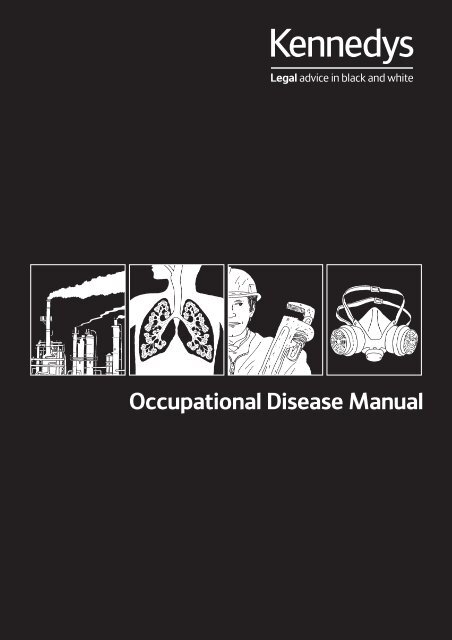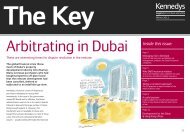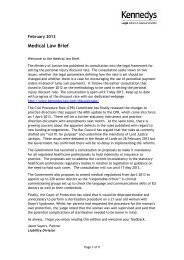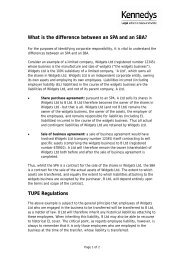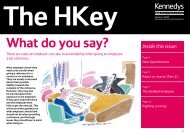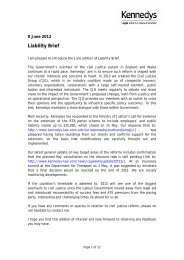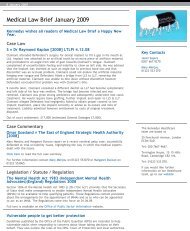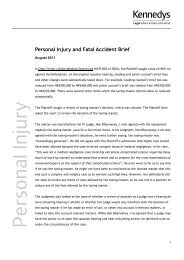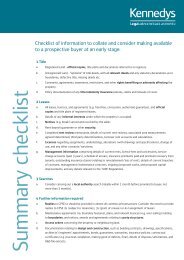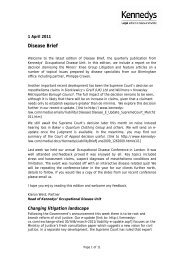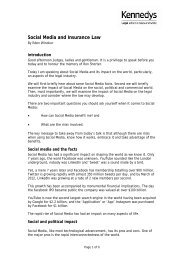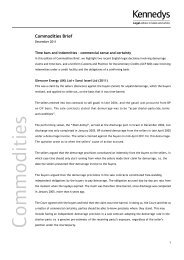Download our Occupational Disease Manual (PDF ... - Kennedys
Download our Occupational Disease Manual (PDF ... - Kennedys
Download our Occupational Disease Manual (PDF ... - Kennedys
You also want an ePaper? Increase the reach of your titles
YUMPU automatically turns print PDFs into web optimized ePapers that Google loves.
<strong>Occupational</strong> <strong>Disease</strong> <strong>Manual</strong>
Foreword<br />
<strong>Occupational</strong> disease and work related disease claims present practitioners with new and<br />
different challenges to those arising from an accident or other single event.<br />
Over the past decade disease claims have generated a significant amount of case law. New<br />
disease and work related conditions have been the subject of claims.<br />
Practitioners need a means of capturing and retaining the wealth of disease related data which<br />
crosses their desk almost on a daily basis. <strong>Kennedys</strong>’ <strong>Occupational</strong> <strong>Disease</strong> Unit has therefore<br />
produced a pocket-sized manual or reference guide which provides information on a number of<br />
occupationally induced conditions and which will hopefully be a useful aide memoire of the<br />
relevant case law.<br />
I sincerely hope that the manual will prove to be a very useful and portable tool.<br />
<strong>Kennedys</strong> offer a national occupational disease service from the offices in Birmingham,<br />
Chelmsford, London, Manchester, Taunton and Sheffield.<br />
Kieron West – Partner and Head of <strong>Occupational</strong> <strong>Disease</strong> Unit<br />
0845 838 4831<br />
k.west@kennedys-law.com
Contents<br />
Topic<br />
Page Number<br />
1. Asbestos Related Illness 2<br />
2. Hand/Arm Vibration Syndrome (HAVS) 7<br />
3. Industrial Asthma 13<br />
4. Industrial Deafness 16<br />
5. Carbon Monoxide (CO) Poisoning 20<br />
6. Contact Dermatitis 22<br />
7. Stress At Work 27<br />
8. Work Related Upper Limb Disorders (WRULDs) 28<br />
9. Other Disorders: 32<br />
l Silicosis 32<br />
l Leptospirosis/Weil’s <strong>Disease</strong> 33<br />
l Fibrotic Hypersensitivity Pneumonitis 35<br />
l Q Fever 36<br />
1
Asbestos Related Illness<br />
Asbestos is a naturally occurring fibrous silicate mineral with well known fire resistant properties.<br />
Its fibrous structure allows it be spun and woven into cloth. Besides its fire resistance, asbestos is<br />
an efficient heat and sound insulator.<br />
When mixed with cement and water, “asbestos cement” can be moulded to make pipes, boards<br />
and tiles. It can be applied by hand to lag heating pipes and boilers. Certain types of asbestos<br />
fibre can even be sprayed. Sprayed asbestos insulation known as “Limpet” spray was used<br />
liberally inside ships and power stations.<br />
TYPES OF ASBESTOS FIBRE<br />
The main types of asbestos fibres are:<br />
Crocidolite – blue asbestos<br />
Amosite – brown asbestos<br />
Chrysotile – white asbestos<br />
Crocidolite and Amosite belonged to a category of asbestos fibres known as amphiboles. Such<br />
fibres are short and rigid and once ingested, are difficult for the lungs to expel.<br />
Chrysotile (white asbestos) has longer but soft, curly fibres known as “serpentine” fibres. These<br />
fibres are more easily cleared from the lungs by the act of coughing.<br />
Because they are more difficult for the body to expel, amphibole fibres have a greater propensity<br />
to cause asbestos induced illnesses, particularly asbestos induced cancers.<br />
Crocidolite is 500 times more toxic in the causation of mesothelioma than is chrysotile. Amosite<br />
is 100 times more toxic than chrysotile in causing mesothelioma. Fortunately, 95% of all of the<br />
asbestos which was imported into the UK comprised chrysotile.<br />
In 1930, the Merewether and Price report highlighted the incidence of asbestosis inside<br />
asbestos manufacturing workshops. Subsequently, their recommendations were given statutory<br />
force by the introduction of the Asbestos Industry Regulations 1931.<br />
Dr Richard Doll made the first association between asbestos exposure and the incidence of lung<br />
cancer in 1955. He noted a significant increase in bronchial tum<strong>our</strong>s amongst asbestotics. Then<br />
in June 1960 a paper was published by an epidemiologist, Dr Christopher Wagner et al<br />
identifying a new form of pleural cancer amongst persons who were living close to a crocidolite<br />
mine in the North West Cape. This paper was the first paper to be written about mesothelioma<br />
2
and its publication proved to be quite controversial amongst epidemiologists and oncologists.<br />
However in 1965 Newhouse & Thompson produced their seminal paper in which they<br />
published their findings relative to persons living in close proximity to an asbestos factory in the<br />
East End of London. Their study established that relatively low-level exposure to crocidolite could<br />
cause mesothelioma in persons who have had no occupational exposure to asbestos. This lead to<br />
the introduction of the Asbestos Regulations 1969. These Regulations not only superseded the<br />
1931 Regulations but applied across the board. They were not restricted to the asbestos<br />
manufacturing industry. Now, anyone using asbestos in any process was required to adhere to<br />
stringent rules of industrial hygiene.<br />
NON MALIGNANT CONDITIONS<br />
1. Diffuse interstitial pulmonary fibrosis a.k.a. asbestosis<br />
This condition is caused by very significant, usually prolonged exposure to asbestos dust and<br />
fibres. The lung tissue becomes clogged with asbestos fibres causing the tissue to fibrose<br />
(become scarred). The scarring restricts the lungs’ ability to expand and so respiratory capacity<br />
is reduced. Asbestosis is dose related and progressive. The condition is incurable and sometimes<br />
fatal. An asbestotic is at an increased risk of contracting lung cancer.<br />
2. Diffuse pleural thickening<br />
This condition is also caused by significant exposure to asbestos. The pleura or lining of the lung<br />
thickens, thus restricting respiratory function. Pleural thickening is also dose related and progressive.<br />
3. Circumscribed pleural thickening a.k.a. pleural plaques.<br />
This is a benign, asymptomatic condition, which is only detectable radiologically. The House of<br />
Lords ruled in the case of Rothwell and Others v Chemical and Insulating Company Limited that<br />
asymptomatic pleural plaques do not constitute an actionable injury. This area remains a hotbed<br />
for political debate. On 8 January 2010 the C<strong>our</strong>t of Session in Scotland rejected the application<br />
made by a number of major insurance companies for judicial review of the Damages (Asbestosrelated<br />
Conditions) (Scotland) Act 2009, which effectively overturns Rothwell as far as claims in<br />
Scotland are concerned and the insurers’ further appeal has since also been rejected [24.04.11].<br />
On 25 February 2010, the MoJ confirmed that the decision in Rothwell is not to be overturned<br />
and pleural plaques will remain non-compensatable (until such time as further medical evidence/<br />
research becomes available). However, the Government accepted that individuals who had made<br />
an understandable claim for pleural plaques prior to the House of Lords ruling in October 2007<br />
3
and whose claims were effectively on hold, would be eligible for a newly created fixed payment<br />
scheme of £5,000. A series of further announcements were made and can be read in greater<br />
detail via the MoJ website http://www.justice.gov.uk/news/newsrelease250210a.htm<br />
MALIGNANT CONDITIONS<br />
1. Lung cancer<br />
Whilst it is clear that many asbestotics go on to contract lung cancer, the most informed medical<br />
opinion now seems to be that where there has been significant exposure to asbestos, then lung<br />
cancer should be considered to be asbestos attributable. In a case where there is asbestosis and<br />
the victim is or has been a heavy smoker, the combined effects of asbestos exposure and<br />
smoking significantly increase the risk of lung cancer.<br />
2. Mesothelioma<br />
This is a rare cancer that is almost always associated with previous asbestos exposure.<br />
This cancer usually occurs in the pleura (i.e. the lining of the lung) but can also occur in the<br />
peritoneum (the lining of the abdominal cavity) and more rarely in other parts of the body.<br />
Mesothelioma is a latent condition and rarely occurs less than 20 years after first exposure.<br />
The mean latency period of a mesothelioma is between 30 and 40 years after first exposure.<br />
The condition is incurable and life expectancy is usually between 6 months and 2 years from the<br />
manifestation of first physical symptoms.<br />
First symptoms usually consist of chest or shoulder pain accompanied by breathlessness because the<br />
pleural cavity has accumulated a significant quantity of a straw col<strong>our</strong>ed fluid. This accumulation of<br />
pleural fluid known as an effusion can be aspirated or drained resulting in a short-term improvement.<br />
Theoretically, chrysotile cannot cause mesothelioma. However, much of the chrysotile used<br />
commercially over the years has been contaminated by tremolite, another type of amphibole<br />
fibre. Whilst mesothelioma is dose related, it can be caused by relatively low levels of exposure.<br />
QUANTUM<br />
The ninth edition of the Judicial Studies Board (JSB) Guidelines provides tabular information as to<br />
the appropriate bracket these claims fall into. In more recent years we have seen an increase in<br />
the higher levels of compensation paid out towards the upper end of the bracket. One such<br />
example is Mayfield v Adelaide Engineering [2009] in which the 68 year old Claimant was<br />
4
awarded £80,000 having undergone surgery and chemotherapy and who was expected to<br />
suffer worsening pain leading up to his death.<br />
(C) Asbestos-related <strong>Disease</strong><br />
(a) Mesothelioma £35,000 to £83,750<br />
(b) Lung cancer £51,500 to £66,000<br />
(c) Asbestosis £31,500 to £69,500<br />
(d) Pleural thickening £25,250 to £51,500<br />
(e) Provisional awards for the least serious<br />
cases within (d) where the provisional<br />
award excludes any risk of the<br />
development of mesothelioma, lung or<br />
other cancer or asbestosis.<br />
£4,350 to £7,250<br />
USEFUL CASE LAW<br />
In the following list of cases you will note we have referred to cases which deal with the issue of<br />
causation, apportionment of damages and knowledge.<br />
Sabin v BRB [2010] – whether the deceased had asbestosis or usual interstitial fibrosis (UIP)<br />
unrelated to asbestos exposure found in fav<strong>our</strong> of the claimant<br />
Fleet v Fleet [2009] EWHC – measure of damages; mesothelioma; death from mesothelioma<br />
Revenue and Customs v Silcock [2009] EWHC – mesothelioma; show cause; allegations of<br />
negligent exposure to asbestos at work; burden of proof at show cause hearings<br />
Horsley v Cascade Insulation Services Ltd [2009] EWHC – asbestosis; contributory negligence;<br />
discounts; future loss; general damages; measure of damages; smoking<br />
Sienkiewicz v Greif (UK) Ltd; Willmore v Knowsley Metropolitan Borough Council [2011] SC –<br />
duty of care, mesothelioma, proof, correct test for determining causation; occupational and<br />
environmental exposure<br />
Abraham v G Ireson & Son (Properties) Ltd [2009] EWHC – extent of asbestos exposure;<br />
causation; foreseeability; knowledge<br />
Durham v BAI (Run Off) Ltd [2010] CA – EL Policy Trigger Litigation: causation; employers’<br />
liability insurance; interpreting determination of event triggering insurer’s liability<br />
5
Brett v Reading University [2007] CA – breach of duty of care; evidence required of breach of<br />
duty; employers’ liability<br />
Barker v Corus (UK) Ltd [2006] HL – causation; several liability; apportionment of liability<br />
according to share of responsibility for creating material risk of mesothelioma<br />
Bolton MBC v Municipal Mutual Insurance Company Ltd and Another [2006] CA – policy<br />
wording, local authorities; accidental bodily injury or illness occurring during currency of policy<br />
Bone v Ministry of Defence [2006] – quantum; award to widow for death of husband from lung<br />
cancer following exposure to asbestos dust at work (1956-1979)<br />
Pinder v Cape Plc [2006] EWHC – duty of care to public to dispose of hazardous waste<br />
appropriately; foreseeability of harm<br />
Badger v Ministry of Defence [2005] EWHC – contributory negligence; lung cancer caused<br />
by smoking and exposure to asbestos; reduction in damages attributable to smoking<br />
Maguire v Harland & Wolff Plc and Another [2005] CA – foreseeability; wife exposed to<br />
asbestos from husband’s clothing; liability for mesothelioma caused by exposure<br />
Rothwell v Chemical and Insulating Limited [2005] HL (formerly known as Grieves and Others<br />
v F T Everard and Sons and Others [2006]) – causes of action; asbestos; pleural plaques; risk of<br />
future disease and consequent anxiety; actionable damage<br />
Fairchild v Glenhaven Funeral Services and Others [2002] HL – mesothelioma; employers’<br />
liability; exposure to asbestos while working for more than one employer; causation<br />
Ballantine v Newalls Insulation Co Limited [2000] CA – measure of damages; industrial diseases;<br />
benefits to be deducted in full from personal injury damages award<br />
Holtby v Brigham and Cowan (Hull) Ltd [2000] CA – joint tortfeasors; asbestosis; exposure to<br />
asbestos by more than one employer; claimant to prove causation; apportionment of<br />
responsibility on time exposure basis<br />
Margereson and Hancock v J W Roberts Limited [1996] CA – liability of factory owner;<br />
reasonable foreseeability of risk of harm established from state of contemporary knowledge<br />
6
Hand/Arm Vibration Syndrome (HAVS)<br />
HAVS is the collective name for injuries to blood vessels, nerves and muscles caused by hand<br />
transmitted vibration. The typical symptoms are tingling, numbness, cold induced whiteness<br />
of the fingers and weakness of grip. HAVS can be defined as a disease with three separate<br />
components:<br />
1. Circulatory disturbances also sometimes referred to as a vasospasm, finger blanching<br />
(“white finger”) or vascular injury;<br />
2. Sensory and motor disturbances also sometimes referred to as neurological injuries; and<br />
3. Muscular skeletal symptoms (although these are sometimes strain related rather than<br />
vibration induced).<br />
The diagnosis of HAVS is based on:<br />
a) The history of the symptoms provided by the patient,<br />
b) The history of relevant and significant vibration exposure, and<br />
c) No evidence of an underlying cause to account for the symptoms.<br />
Note that Raynaud’s Phenomenon (which is a descriptive term for cold induced episodic<br />
whiteness affecting the fingers which is the principal vascular symptom of HAVS) may be caused<br />
by Raynaud’s disease that is a constitutional condition. It can also be caused by connective tissue<br />
disease, arterial disease, toxins/drugs as well as having traumatic causes that include but are not<br />
limited to hand transmitted vibration.<br />
The level of symptomology is classified according to the Stockholm Workshop Scale that assesses<br />
both neurological and vascular symptoms.<br />
7
Table 1 – The Stockholm Workshop Scale for the classification of Cold-Induced Raynaud’s<br />
Phenomena in the Hand/Arm Vibration Syndrome<br />
STAGE GRADE DESCRIPTION<br />
0 No attacks.<br />
1 Mild Occasional attacks affecting only the tips of one or more fingers.<br />
2 Moderate<br />
Occasional attacks affecting distal and middle<br />
(rarely also proximal) phalanges of one or more fingers.<br />
3 Severe Frequent attacks affecting all phalanges of most fingers.<br />
4 Very Severe As in Stage 3, with trophic skin changes in the fingertips.<br />
Note that the staging is made separately for each hand. In the evaluation of the subject the<br />
grade of the disorder is indicated by the stages of both hands and the number of affected<br />
fingers on each hand e.g. “2L(2)/1R(1).”<br />
Table 2 – Sensorineural Stages of the Hand/Arm Vibration Syndrome<br />
STAGE<br />
SYMPTOMS<br />
0 SN Exposed to vibration but not symptoms.<br />
1 SN Intermittent numbness with or without tingling.<br />
2 SN Intermittent or persistent numbness, reduced sensory perception.<br />
3 SN<br />
Intermittent or persistent numbness, reduced tactile discrimination<br />
and/manipulative dexterity.<br />
FORESEEABILITY/DATE OF KNOWLEDGE<br />
This is the date when any individual employer ought first to have recognised that work with<br />
vibratory equipment gave rise to a foreseeable risk of injury.<br />
1975 is often referred to as being the date of knowledge however it is important to consider<br />
whether this is in fact appropriate for each individual case since the date of knowledge in HAVS<br />
cases varies between industries and many cases draw a distinction between the date when the<br />
employer should have been aware of the risk and the date by when it should have instituted<br />
precautions to reduce or eliminate that risk.<br />
8
Examples of various dates of knowledge are:<br />
Rail Industry – knowledge of risk ought to have arisen by 1973 and by the end of 1973 a<br />
system of issuing warnings to work as ought to have been in place and by the end of the<br />
following year periodical medical surveillance ought to have been introduced to all employers<br />
exposed to the use of hand held vibratory equipment [Allen v British Rail Engineering Ltd [1998].<br />
Coal Industry – date of knowledge 1973 with an obligation to take precautionary steps by<br />
issuing warnings and undertaking medical surveillance by 1975, a duty to undertake job rotation<br />
by 1976 and a duty to adapt tools to minimise vibration at some unspecified point thereafter<br />
[Armstrong v British Coal Corporation 31 July [1998].<br />
Woodworking Industry – date of knowledge 1991-1992 by which point employers should<br />
have been monitoring their employee’s health with respect to vibration injuries (Doherty v Rugby<br />
Joinery [2004] EWCA Civ147).<br />
BREACH OF DUTY<br />
Vibration Levels<br />
For a claimant to establish breach of duty he must first show that the defendant exposed him<br />
to “excessive vibration” (i.e. vibration which exposed him to a foreseeable risk of injury) and<br />
secondly that he failed to take appropriate and necessary precautionary/preventative measures<br />
to reduce the risk of injury to an appropriate level.<br />
The key standards that had been published addressing vibration levels are:<br />
l<br />
l<br />
l<br />
Draft Development Standard published by the British Standards Institution in 1975 “DD43”.<br />
This stated vibration magnitudes of below 1.0 ms 2 were acceptable vibration magnitudes and<br />
magnitudes above 10ms 2 were unacceptable vibration magnitudes. This upper limit apply to<br />
exposure durations of 2 1 /2 h<strong>our</strong>s and less per day. The lower boundary of 1 ms 2 applied to<br />
exposure durations of 400 ms 2 per day roughly up to 2 1 /2 h<strong>our</strong>s it should be 150 minutes.<br />
Health and Safety Executive Guidance Document HS(G)88. This guidance was published in<br />
1994 but is based upon the British Standard BS 6842 first published in 1987.<br />
HS(G)88 prescribes an “action level” of 2.8 ms 2 A(8). The A(8) is a reference to an assumed<br />
or normal h<strong>our</strong>s working day of 8 h<strong>our</strong>s. Therefore 2.8 ms 2 A(8) is a measure of the average<br />
vibration level over the c<strong>our</strong>se of the 8-h<strong>our</strong> working day.<br />
9
l<br />
The action level of 2.8 ms 2 A(8) is not a “safe” level of vibration which if it is complied with it<br />
is likely to avoid all injury. The action level is based upon statistical data demonstrating that a<br />
vibration dose equivalent to the action of 2.8 ms 2 A(8) would result in 10% of the exposed<br />
population developing symptoms of HAVS within 8 years.<br />
l The Control of Vibration at Work Regulations 2005.<br />
http://www.opsi.gov.uk/si/si2005/20051093.htm<br />
These came into force on 6 July 2005 and define exposure limits as 5 ms 2 A(8) and daily<br />
exposure actions value as 2.5 ms 2 A(8). Note that these measurements differ from those set<br />
out in the earlier Standard and Guidance due to the way in which the vibration level is now<br />
measured. As such the levels are not directly comparable.<br />
The employer is required not to expose employees or others who may be affected by his work to<br />
vibration levels above the exposure limit. Where it is not reasonably practicable to eliminate the<br />
risk from exposure to vibration at s<strong>our</strong>ce and the exposure action limit is likely to be reached or<br />
exceed the employer is required to reduce exposure levels to the lowest level reasonably<br />
practicable.<br />
Liability at Common Law<br />
The employers’ common law duty of care is not an absolute one but rather one of reasonable<br />
care in all the circumstances including any known susceptibility or vulnerability of the employee.<br />
Not every exposure to vibration will suffice potentially to found liability. The exposure will need<br />
to be significant and such as to give rise to a foreseeable risk of injury. Tortious exposure will<br />
almost always be in excess of A8 of 1.0 ms.<br />
An employer will need to show that he has taken reasonable steps to control exposure to<br />
vibration if he is to avoid liability at common law. These include:<br />
l<br />
l<br />
l<br />
l<br />
Pre-employment screening for HAVS symptoms;<br />
Providing training and information to employees on the nature of the risk from vibration<br />
and what signs or symptoms they should look out for and report;<br />
Providing routine health surveillance;<br />
Controlling vibration levels by, where possible, engineering out processes which expose the<br />
employee to vibration and where not using tools designed for low vibration and properly<br />
maintaining these;<br />
10
l<br />
l<br />
Controlling how the employees work so as to limit exposure times (e.g. by way of breaks and<br />
job rotation); and<br />
Ensuring tools are handled in such a way so as to limit vibration being transmitted into the<br />
hand e.g. by training employees not to grasp tools tightly.<br />
Liability under Statute<br />
The Control of Vibration at Work Regulations 2005 set out obligations to:<br />
l<br />
l<br />
l<br />
l<br />
Elimination or control of exposure to vibration at the workplace;<br />
Assess of the risk to health created by vibration at the workplace;<br />
Provide health surveillance where the is a risk to health from vibration or the exposure action<br />
limit is likely to be reached or exceeded; and<br />
Provide information, instruction and training where the is a risk to health from vibration or<br />
the exposure action limit is likely to be reached or exceeded.<br />
Quantum<br />
(i) Most Serious £20,750 to £25,250<br />
(ii) Serious £11,000 to £20,750<br />
(iii) Moderate £5,700 to £11,000<br />
(iv)Minor £2,000 to £5,700<br />
Apportionment<br />
HAVS is a divisible, dose related condition the causation of which is capable of apportionment<br />
between those who have exposed the claimant to vibration in line with the principles of<br />
Holtby v Brigham & Cowan (Hull) Ltd [2000] i.e. the defendant should only be liable for those<br />
symptoms which his breach of duty has caused.<br />
However the position is often complicated since, unlike the linear development of NIHL, there will<br />
usually be a latent period where exposure may have been negligent but there are no symptoms.<br />
Claimants are often described as having a “vibration reservoir” which is gradually “filled” by<br />
exposure to vibration but where they do not develop symptoms. When that “reservoir” is full the<br />
claimant goes on to develop symptoms.<br />
11
There are often multiple employers and therefore defendants in these cases. Often the claimant<br />
has not developed symptoms until a later period of employment. This could give rise to the<br />
argument that in the absence of any injury the claimant has no right of action against a<br />
defendant who has exposed the claimant to vibration but where there is no temporal connection<br />
with the development of symptoms. There is no definitive case law on this issue yet.<br />
In practise, defendants and insurers often take a pragmatic approach by apportioning quantum on a<br />
time exposed basis in the absence of specific evidence on levels of exposure during the exposure<br />
period even where symptoms may not have developed until a later period of employment.<br />
However in the case of Brookes v South Yorkshire Passenger Transport Executive (1) and Mainline<br />
Group Ltd (2) [2005] the C<strong>our</strong>t of Appeal addressed a facet of this issue when looking at<br />
whether an employee’s damages should be discounted for pre-date of knowledge (and therefore<br />
innocent) exposure. The claimant in that case had not developed symptoms until some years<br />
after the negligent exposure of one of the defendants had begun. The C<strong>our</strong>t ruled that there<br />
should be no discount, as without the negligent exposure the claimant would have never<br />
developed symptoms.<br />
Some defendants and insurers are seeking to rely upon this case to support the proposition that<br />
all of the liability for damages should fall to the defendant who was the claimant’s employer<br />
when symptoms arose. There is some force in this but there is no direct case law on the point.<br />
12
Industrial Asthma<br />
This is a disease process caused by the narrowing or inflammation of the lung passageways<br />
making breathing difficult. Symptoms include wheezing, tightness in the chest and difficulty<br />
exhaling air. Most people with asthma have sudden attacks or periods of more severe symptoms<br />
interspersed with periods of mild or no symptoms at all. When a person with asthma is exposed<br />
to one of the triggers personal to that individual, the airways begin to swell and narrow, making<br />
it difficult to exhale. Asthma cannot be cured but can be controlled by medication. The earlier<br />
the diagnosis, the better the prospects for greater control and avoidance of permanent lung<br />
inflammation and airway hypersensitivity.<br />
WHAT IS OCCUPATIONAL ASTHMA?<br />
A respiratory disease caused by exposure to a trigger in the workplace, usually inhaled.<br />
Potential triggers are wide ranging and can be found in almost any workplace, including offices,<br />
factories, shops and hospitals. The list of industries and jobs where there may be exposure to<br />
triggers include plastics, rubber, chemicals, textiles, electronics, baking, food processing,<br />
cleaning, spray painting, soldering and welding. It must be remembered that constitutional<br />
asthma is very commonly triggered by exposure to a wide range of common irritants such as<br />
pollen, perfume, animal fur, house dust mites and tobacco smoke. <strong>Occupational</strong> asthma can thus<br />
occur as:<br />
l<br />
l<br />
an aggravation of a pre-existing condition caused by regular exposure to a new trigger<br />
causing hypersensitivity to the trigger and resultant attacks, or<br />
an irritant asthma caused by exposure to certain substances or conditions in the workplace<br />
irritating the airways with immediate symptoms.<br />
Risk factors for occupational asthma include:<br />
l<br />
l<br />
l<br />
l<br />
Frequent exposure to the triggers;<br />
Allergies;<br />
Family history; and<br />
Smoking.<br />
13
<strong>Occupational</strong> asthma requires a history of exposure to a sensitising agent. The latency period<br />
depends on the substance but can range from a matter of weeks to years. Medical causation is<br />
particularly difficult because of the prevalence of the condition to the general public. Issues to be<br />
considered include:<br />
l<br />
l<br />
l<br />
l<br />
Temporal relationship between exposure to a workplace trigger and the onset of symptoms;<br />
Variability of airflow obstruction measured by peak expiratory flow rates and spirometry;<br />
Patch testing as evidence of the sensitivity to the alleged trigger; and<br />
Personal/family history.<br />
Data released by the HSE indicates that the incidence has fallen as a result of better control but<br />
occupational asthma remains a major concern.<br />
APPLICABLE LAW<br />
The most significant legislation is the Control of Substances Hazardous to Health<br />
Regulations [1998] [COSHH] as amended in 2002 and 2004 and specific guidance notes<br />
released by the HSE. COSHH requires an employer to control substances that are hazardous to<br />
health. The standard is a very high one. The aim of the regulatory regime is to provide a uniform<br />
code of the control of any substance that may be harmful to health.<br />
The HSE also publish a list of “<strong>Occupational</strong> Exposure Limits” [OEL] for over 700 substances<br />
including short term [15 minutes] and long term [eight h<strong>our</strong>s] exposure limits.<br />
The definition of a substance hazardous to health is extremely wide. It includes substances with<br />
specified occupational exposure limits, biological agents, infectious bacteria and viruses, dust of<br />
any kind in substantial concentrations in air or any other substance which because of its<br />
chemical or toxicological properties creates a risk of injury to health.<br />
Date of knowledge under common law is unlikely to provide grounds for defence in occupational<br />
asthma cases. In Dugmore v Swansea NHS Trust [2002] the C<strong>our</strong>t of Appeal held that a date of<br />
knowledge defence was not relevant when applying Regulation 7 of COSSH. The case concerned<br />
the risk of wearing latex gloves causing sensitisation. The C<strong>our</strong>t of Appeal held that the question<br />
of knowledge of the risk was irrelevant as:<br />
“Every employer shall ensure that exposure of his employees to substances hazardous to<br />
health is either prevented or where this is not reasonably practicable, be adequately<br />
controlled”.<br />
14
The Dugmore decision means that foreseeability is not an issue to be considered under COSHH.<br />
“Regulation 7, sub-section 1 uses the language of strict liability and providing that an<br />
employer shall ensure that exposure is either prevented or adequately controlled. The<br />
primary duty is to prevent exposure altogether unless this is not reasonably practicable…<br />
nowhere is there any reference to the reasonable foreseeability of risk. Nor is the duty<br />
dependent upon what a risk assessment would have revealed”.<br />
In these circumstances, where a causative connection is established between the substance and<br />
the asthmatic condition, it will be virtually impossible for any employer to escape liability.<br />
QUANTUM<br />
(D) Asthma<br />
(a) Severe and permanent disabling asthma £28,250 to £43,000<br />
(b) Chronic asthma £17,250 to £28,250<br />
(c) Bronchitis and wheezing £12,600 to £17,250<br />
(d) Relatively mild asthma-like symptoms £7,000 to £12,600<br />
(e) Mild asthma, bronchitis, colds and chest<br />
problems<br />
Up to £3,400<br />
15
Industrial Deafness<br />
Traditionally those at particular risk of hearing damage were those in heavy industry such as<br />
shipbuilding, metal work, drilling and quarrying or where the use of noisy machinery is utilised<br />
such as engineering, woodworking, textiles and printing. Many heavy industries have<br />
disappeared or been scaled down and new plant and methods of working introduced with<br />
consequent reduction in noise levels. Nevertheless in spite of this and the increased awareness<br />
of the risk and controls over noise levels, noise induced deafness still occurs during the c<strong>our</strong>se of<br />
employment and insurers continue to receive a steady stream of deafness claims. The main<br />
difference from the thousands of claims of the seventies and eighties is that present day claims<br />
concern, in the greater part, lower levels of hearing loss.<br />
HOW IS NOISE DEAFNESS CAUSED?<br />
The cochlea, a spiral cavity in the inner ear, is filled with fluid and lined by cells with very fine<br />
hairs. For reasons that are not entirely clear, some of these cells are more sensitive than others<br />
to unwanted sound or noise and are damaged as a result of exposure. Over time hearing acuity<br />
can be compromised by exposure to such noise.<br />
The first symptom of noise induced hearing loss is usually difficulty hearing a conversation<br />
against a noisy background such as in a busy restaurant. Sometimes this hearing loss is<br />
accompanied with intermittent high-pitched ringing in the ears called tinnitus. Typically, by the<br />
time the symptoms have become sufficient to prompt medical consultation and to be measured<br />
by audiometry, the damage will be severe and with every further session of noise exposure<br />
progressive.<br />
Sound can measured scientifically in terms of intensity but also be related to particular frequency<br />
bands. Pitch or frequency is measured in hertz [Hz]. The higher the pitch will sound, the higher<br />
the frequency of it. Sound intensity is measured in decibels [dBA].<br />
Noise induced hearing loss will begin to affect the hearing of certain frequencies. This can be<br />
noted with a dip on an audiogram usually at the 4 – 5 KHz’s range. With continued exposure to<br />
noise, the loss of sound perception progresses both in severity and into lower frequency ranges<br />
as well.<br />
NIHL CLAIMS<br />
During the 1970s and early 1980s thousands of deafness claims were litigated many on behalf of<br />
shipyard workers who had been exposed to decades of noise. In the lead case of Thompson v<br />
Smiths ShipRepairers [1984] it was decided that from 1963 employers exposing employees to<br />
16
levels of noise in excess of 90 dB[A] were in breach of duty until such time as adequate ear<br />
protection was provided. Claimants were thus only able to recover for damage suffered between<br />
those dates. The many who had been exposed to noise prior to 1963 were thus only compensated<br />
for the proportion of their hearing loss attributable to the negligent exposure post 1963.<br />
The decision was based on a detailed review of the medical and other information available to an<br />
employer about the need to protect employees against noise. On the key question of date of<br />
knowledge it was decided that until the early sixties, the need to protect employees was not<br />
generally known and so negligence was not established in respect of prior employment.<br />
As a result of the Thompson decision as well as various agreements reached between Insurers<br />
and certain Unions for payment of scaled compensation, there was comparatively little industrial<br />
deafness litigation until the late nineties when attention was directed to the potential for damage<br />
at levels of noise less than the 90 dB[A] threshold.<br />
In Baker v Quantum Clothing, Meridian Limited and Pretty Polly Limited [2011] the Supreme<br />
C<strong>our</strong>t considered the alleged hearing loss suffered by textile workers, prior to the introduction of<br />
the Noise at Work Regulations 1989 on 1 January 1990, where the noise exposure had been<br />
between levels of 85 to 90dB[A].<br />
At first instance it was held that at common law, the acceptable standard for the average employer<br />
to adhere to was 90dB[A], as per the 1972 Code of Practice published by the Department of<br />
Employment. The second European draft Directive, which ultimately became the Noise at Work<br />
Regulations 1989, was published in 1987. From that date, average employers should have been<br />
aware as to the risks of noise exposure between 85 and 90dB[A]. A period of two years was<br />
allowed for employers to implement protective measures, meaning that the average employer had<br />
no common law liability before 1 January 1990 (although this precise date was not made clear,<br />
but has since been clarified by the Supreme C<strong>our</strong>t). A distinction was made for employers with<br />
greater than average knowledge who were held to have a date of knowledge from 1983. The<br />
same two year implementation period was applied and they were therefore in breach from 1985.<br />
Section 29(1) of the Factories Act 1961, which stated that “every place at which any person has<br />
at any time to work … shall, so far as is reasonably practicable, be made and kept safe for any<br />
person working there”, did not add materially to the common law duty.<br />
However, on appeal to the C<strong>our</strong>t of Appeal, whilst the common law position was agreed, the<br />
implementation period for protective measures was restricted to six to nine months and, as such,<br />
liability arose from January 1988 and late 1983 respectively. The fundamental difference in the<br />
C<strong>our</strong>t of Appeal judgment related to Lady Justice Smith’s interpretation of Section 29. It was held<br />
17
that the definition of “safe” was objective, unchanging and independent of any foresight of injury.<br />
The only qualification was for an employer to show that it was not reasonably practicable to reduce<br />
or avoid the noise exposure. As a consequence, by late 1976 an average sized employer in the<br />
knitting industry could and should have been able to make an informed assessment of the risk<br />
arising from exposure below 90dB[A].<br />
The Supreme C<strong>our</strong>t restored the first instance decision by a majority of 3:2. The Supreme C<strong>our</strong>t<br />
held that common law employers with average knowledge were potentially liable from 1 January<br />
1990 and those with greater than average knowledge from 1 January 1985.<br />
Section 29 had not previously been considered at the highest level and it was held as follows:<br />
l<br />
l<br />
l<br />
l<br />
l<br />
Whether a workplace was safe involved a judgment which was objectively assessed but by<br />
reference to the knowledge and standard of the time.<br />
Section 29 could apply to the activity and was not restricted just to the physical condition of<br />
the premises.<br />
There was no such thing as an unchanging concept of safety.<br />
The fact that a single person has suffered injury due to some feature of the workplace was not,<br />
on its own, proof that the workplace was unsafe. The successor legislation to the Factories Act,<br />
the Health and Safety at Work Act 1974, did not aim to create an environment that was<br />
entirely risk free and therefore it would be strange if Section 29 had a more stringent effect.<br />
The purpose of the Factories Act was to reinforce the common law obligation of an employer to<br />
take care of the safety of its workers. The C<strong>our</strong>t of Appeal had found that statute must differ<br />
from the common law, otherwise it would be otiose. However, the Supreme C<strong>our</strong>t held that<br />
there was no principle of law that a statutory duty cannot be interpreted as being co-terminous<br />
with a common law duty.<br />
The Supreme C<strong>our</strong>t’s decision is reassuring to both textile industry employers and insurers and<br />
provides welcome clarity to the basis on which deafness claims should be reserved. It has been<br />
confirmed that the average employer will have no common law liability prior to 1 January 1990 for<br />
noise levels below 90dB[A]. Consequently the decision prevents a floodgate of potential claims.<br />
18
QUANTUM<br />
The following table is based upon the JSB Guidelines:<br />
(a) Total Deafness and Loss of Speech £72,000 to £92,000<br />
(b) Total Deafness £59,500 to £72,000<br />
(c) Total Loss of Hearing in One Ear £20,500 to £30,000<br />
(d) Partial Hearing Loss/Tinnitus<br />
(i)<br />
Severe tinnitus/hearing loss<br />
£19,500 to £30,000<br />
(ii) Moderate tinnitus/hearing loss<br />
(iii) Mild tinnitus with some hearing loss<br />
(iv) Slight or occasional tinnitus with slight<br />
hearing loss<br />
£9,750 to £19,500<br />
£8,250 to £9,570<br />
£4,850 to £8,250<br />
19
Carbon Monoxide (CO) Poisoning<br />
CO poisoning arises as a result of incomplete combustion of gas. Commonly claims arise against<br />
local authorities as the landlord of premises, which contain defective boilers and gas fires.<br />
<strong>Occupational</strong> claims may also arise against bus or haulage companies as a result of carbon<br />
monoxide fumes from faulty exhaust systems penetrating the driver’s cab of buses or lorries.<br />
LIABILITY<br />
Local authorities are subject to statutory regulations to provide gas services; to maintain all gas<br />
installations and to ensure the safety of the gas supply/installation. Local authorities are subject<br />
to onerous statutory duties to ensure that gas supplies and installations in their housing stock<br />
are safely installed and maintained. In reality, local authorities subcontract the provision of<br />
gas supplies and installations but they are unable to delegate their statutory duties to their<br />
sub-contractors. They remain liable to their tenants but invariably have rights of indemnity as<br />
against their contractors in respect of any liability they may incur by reason of the negligent<br />
acts and omissions of those contractors. Consequently, it is important to consider the specific<br />
contractual terms between the landlord and his sub contractor.<br />
LIMITATION<br />
The claimant’s time for bringing a claim begins to run from the date he/she first knew or ought<br />
reasonably to have ascertained that his/her symptoms were caused by the exposure to carbon<br />
monoxide fumes from the defective appliance.<br />
Disclosure of the claimant’s medical records will be required before determining the claimant’s<br />
date of knowledge.<br />
LEVELS AND SYMPTOMS OF CO POISONING<br />
Levels of this gas are measured in parts per million (“ppm”). CO levels become toxic when levels<br />
greater than 50 ppm are reached provided the exposure is continuous over an eight-h<strong>our</strong><br />
period. Higher than 50 ppm and a person is likely to suffer from symptoms of exposure.<br />
Mild exposure over a few h<strong>our</strong>s with a CO level between 70 ppm and 100 ppm will include<br />
flu-like symptoms such as headaches, sore eyes and a runny nose.<br />
Medium exposure with a CO level between 150 ppm to 300 ppm will produce dizziness,<br />
drowsiness and vomiting.<br />
Extreme exposure with a CO level of 400 ppm and higher will result in unconsciousness,<br />
brain damage and death.<br />
20
INVESTIGATING CO POISONING CLAIMS<br />
When investigating these types of claims consideration should be given to:<br />
1. Documentation (such as tenancy agreements). These will confirm who owns or has<br />
responsibility for the property and the defective appliance. The gas service agreement will<br />
determine the contractual obligations between the local authority and any sub-contractor.<br />
The sub-contractor should be asked to produce evidence of all inspections; services repair<br />
records and so forth in order to establish any negligence on their part.<br />
2. Expert engineering evidence will be required to determine the level and duration of<br />
CO exposure.<br />
3. It is important to analyse what symptoms are alleged and whether there is corroborative<br />
evidence of the same within the claimant’s medical records. Analysis of the symptoms alleged<br />
should be cross-referenced with the levels of CO exposure to see if the alleged symptoms are<br />
consistent with the degree of known exposure. A report from a medical toxicologist should<br />
be sought and read in conjunction with the engineering evidence. It is important to retain a<br />
medical toxicologist rather than a toxicologist because you will wish to have the claimant<br />
medically examined and his or her medical records analysed.<br />
4. The extent of the exposure. If the exposure is extreme and cognitive deficit is claimed,<br />
seek evidence relating to the claimant’s pre-morbid intellectual ability such as<br />
school/college/employment records. Neuropsychological testing will enable the defendant<br />
to establish whether the exposure has resulted in a reduction to the claimant’s pre-morbid<br />
cognitive ability and how this will impact upon the claimant’s future earnings capacity.<br />
5. The claimant’s health prior to the alleged exposure including whether the claimant smoked or<br />
suffered with any respiratory problems such as asthma, chronic airways disease etc.<br />
QUANTUM<br />
The extent of injury that arises out of CO poisoning is so wide ranging that the damages awarded<br />
can be nominal to high value figures where exposure has resulted in brain injury and consequential<br />
psychiatric problems. The claims of (1)B(2)E(3)F(4)G(5)H(6)J(7)K v Centre Islands Holiday<br />
Limited [2009] recently settled with damages ranging from £1,500 to £6,750 for differing levels<br />
of exposure. Whereas in the case of Peter George Etheridge (By His Litigation Friend The Official<br />
Solicitor) V Millar & Anor [2000] an out of c<strong>our</strong>t settlement was reached at £585,000.<br />
21
Contact Dermatitis<br />
Dermatitis is irritation of the skin or derma, which causes the skin to become inflamed.<br />
Dermatitis can occur either constitutional (endogenous dermatitis) or due to exposure to an<br />
external substance (exogenous dermatitis).<br />
There are two main types of contact dermatitis:<br />
1. Irritant Contact Dermatitis<br />
Irritants cause approximately 80% of cases of contact dermatitis and irritant reaction is caused<br />
due to the penetration of the epidermis by an external substance, which either irritates or<br />
sensitises the living cells below. The extent of cell damage depends on the strength of the<br />
substance involved and the period of which the skin is exposed.<br />
Chronic irritant contact dermatitis is caused by multiple exposures, often due to several irritants<br />
at low levels over time. This can take many months, or even years to appear. The usual c<strong>our</strong>se of<br />
events is that each exposure adds to the gradual disruption of the outer layer of skin, and each<br />
time inflammatory mediators are released. The epidermis gradually thickens and the fat layer in<br />
the skin is gradually damaged. The affected skin looses its ability to function as a barrier, and<br />
consequently further exposure to an irritant produces further damage, with the final result being<br />
dryness, scaling and thickening of the skin.<br />
Acute irritant contact dermatitis is usually caused by a single exposure to a substance which<br />
causes irritation within either minutes or h<strong>our</strong>s of exposure. The usual c<strong>our</strong>se of events is that<br />
the irritant substance penetrates the skin damaging the membranes of the skin cells. The cell<br />
damage prompts the release of chemicals that trigger the immune system into action resulting<br />
in the appearance on a mild reaction consisting of transient redness, or any on a more severe<br />
reaction to painful burns with blistering.<br />
Each individual has their own susceptibility level. Both sexes are equally susceptible to irritant<br />
contact dermatitis.<br />
2 . Allergic Contact Dermatitis<br />
Allergic contact dermatitis accounts for the remaining 20% of contact dermatitis cases. Allergic<br />
contact dermatitis is often difficult to tell from irritant contact dermatitis, but its aetiology is different.<br />
The cause of allergic contact dermatitis is an immune reaction known as “delayed<br />
hypersensitivity” reaction. The characteristic feature of the immune reaction is a delay between<br />
the first exposure to an allergen and the subsequent reaction. Consequently allergic contact<br />
dermatitis occurs in two stages, firstly there is the “sensitisation”. This is where the substance<br />
22
penetrates the skin before binding to a skin immune cell which then travels to the lymph nodes.<br />
The allergen is “shown” to another type of immune cell which proliferates and causes “memory”<br />
cells that remember the particular allergen.<br />
Once sensitisation has occurred subsequent exposure to the allergen causes the immune cell<br />
to recognise the allergen, thus activating the immune cells causing them to multiple and the<br />
ongoing immune reaction results in an eczema-like inflammation of the skin at the site of<br />
contact. This phase usually occurs within 48 to 72 h<strong>our</strong>s after exposure.<br />
Once the allergy has established itself, even minor future exposures to the allergen can set it off.<br />
However avoidance of the allergen will result in resolution of the rash.<br />
The communist allergens are nickel, fragrances, rubber/latex, some types of plant, formaldehyde,<br />
skin medications (including topical corticosteroids), some make-up and hairdressing chemicals.<br />
As with irritant contact dermatitis, allergic contact dermatitis is more common in atopic<br />
individuals.<br />
Approximately 75% of all contact dermatitis cases affect the hands. Contact dermatitis is more<br />
common in women, with approximately 20% of females experiencing contact dermatitis on their<br />
hands at some point during their lives. This may be because of the increased risk from cosmetics<br />
and other substances used in hairdressing, beauty products and cleaning.<br />
MEDICAL CAUSATION<br />
There are many causes of contact dermatitis involving a wide range of substances and<br />
consequently it is essential to clarify the medical causation. There are several types of eczemalike<br />
reactions that can produce a similar appearance to contact dermatitis including:<br />
l<br />
l<br />
l<br />
l<br />
l<br />
Atopic Eczema;<br />
Seborrhoeic Eczema;<br />
Discoid (or immular) Eczema;<br />
Pompholyx, dyshidrotic or vesicular Eczema; and<br />
Stasis or venous Eczema.<br />
Whilst the above are not necessarily caused by either irritant or allergic contact dermatitis, they<br />
can be exacerbated by such.<br />
23
Before making any diagnosis, the medical expert involved should also consider other skin<br />
conditions such as:<br />
l<br />
l<br />
Drug related appearance, usually suggested by a history of rash that occurs after starting a<br />
new drug treatment.<br />
Fungal infection, this can usually be determined by taking skin scrapings and examining them<br />
under a microscope.<br />
Patch testing can also be used to check for allergies. Suspected allergens are usually applied to<br />
the back under aluminium discs or patches which are then left in place for 48 h<strong>our</strong>s, before<br />
being removed and the skin inspected.<br />
ALLEGED OCCUPATIONAL CONTACT DERMATITIS<br />
Where a person’s occupation is suspected of causing dermatitis then it is essential for the medical<br />
expert (usually a Consultant Dermatologist) to be provided with information in relation to the<br />
claimant’s full medical history and any previous allergic reaction to any substances. As it is essential<br />
for the expert to ascertain exactly what substances are used/touched during a claimant’s<br />
occupation, involving not only a description of the materials, but also the various processes<br />
involved. The expert should also establish the duration and frequency of the task carried out and<br />
ascertain what protective clothing, barrier creams or cleaning controls that are implemented.<br />
When investigating claims generally insurers should arrange for a detailed description of the<br />
claimant’s medical and working history to be obtained, together with any changes in the<br />
claimant’s working environment, including such items as lighting, heating, ventilation, cleanliness<br />
and housing-keeping etc. The insured should also be asked to provide information in relation to<br />
the operating procedures and engineering controls and any changes which have been made to<br />
them and reasons for the same. A detailed description of the claimant’s working area together<br />
with any photographs or sketch plans should be obtained together with details of who else was<br />
using any of the materials involved. Full information in relation to the instruction and training<br />
provided to the claimant together with the type and level of supervision provided.<br />
It is occasionally difficult to investigate contact dermatitis claims due to the passage of time<br />
involved and the potential sensitisation period if one is dealing with allergic contact dermatitis.<br />
However the investigation does need to be done methodically and carefully and it is important<br />
that no immediate conclusions should be jumped at purely on the basis of a Letter of Claim<br />
without any proper investigation and medical evidence to show causation.<br />
24
RELEVANT STATUTORY REGULATIONS<br />
The main regulations applicable to contact dermatitis are as follows:<br />
l Control of substances hazardous to Health Regulations 2002.<br />
l<br />
l<br />
Duties in COSHH are owed by employers to their employees and others whom may be affected<br />
by the work carried out by the employer, save that Health Surveillance (Regulation 11) is only<br />
owed to employees. Under Regulation 6 there is a duty on an employer to make a suitable and<br />
sufficient risk assessment, and under Regulation 7, to ensure that the exposure of employees to<br />
substances are prevented, or where that is not reasonably practicable, adequately controlled.<br />
Where one might have expected the Personal Protective Equipment Regulations 1992 and the<br />
Provision and Use of Work Equipment Regulations 1998 to apply, COSHH takes precedence.<br />
CAUSATION<br />
The leading case in relation to causation is McGhee v National Coal Board [1973] HL. McGhee<br />
was a miner, employed on hot and dusty duties buy the Coal Board, who had failed to provide<br />
any washing facilities. As a result the claimant had to cycle home caked in sweat and grime. This<br />
increased the risk of his contracting dermatitis. The House of Lords held that simply increasing<br />
the risk by a more than negligible amount (i.e. by a material amount) due to a breach of duty was<br />
sufficient to result in legal liability.<br />
However difficult questions regarding non-negligent exposure, constitutional vulnerability and<br />
the basis for diagnosis of the type of contact dermatitis will often arise and should be considered<br />
carefully before conceding liability.<br />
More recently in Dugmore v Swansea NHS Trust [2002] CA – a case involving an NHS nurse who<br />
became sensitised to latex from wearing latex rubber gloves as part of her work equipment – the<br />
C<strong>our</strong>t of Appeal has created an absolute duty on behalf of employers. This was a case decided<br />
under COSHH Regulation 7. The C<strong>our</strong>t held there is a duty to ensure that exposure is prevented<br />
or controlled, and this was an absolute duty, not subject to the usual sanction of reasonable<br />
foreseeability. The C<strong>our</strong>t held that the defence of reasonable practicability only qualified the duty<br />
of total prevention and not the duty to ensure the exposure is adequately controlled.<br />
25
QUANTUM<br />
The 9th Edition of the JSB Guidelines for the Assessment of General Damages in Personal Injury<br />
Cases provides three separate brackets for general damages.<br />
(a) Dermatitis of both hands, with cracking<br />
and soreness, affecting employment and<br />
domestic capability, possibly with some<br />
psychological consequences, lasting for<br />
some years, perhaps indefinitely.<br />
(b) Dermatitis of both hands, continuing for a<br />
significant period, but settling with<br />
treatment and/or use of gloves for<br />
specific tasks.<br />
(c) Itching, irritation of and/or rashes on one<br />
or both hands, but resolving within a few<br />
months with treatment.<br />
£9,000 to £12,600<br />
£5,700 to £7,500<br />
£1,125 to £2,600<br />
26
Stress At Work<br />
<strong>Occupational</strong> stress is on the increase, however, unlike many other disease areas, companies and insurers<br />
have got good prospects of defending these claims, provided the proper investigations are carried out and<br />
the right medical experts instructed.<br />
Most claims are advanced in negligence but statutory breaches are often pleaded including the<br />
Management of Health and Safety at Work Regulations 1999 (failure to carry out a risk assessment<br />
and/or a breach of the Working Time Regulations).<br />
In relation to the latter, defendants can rely on Sayers v Cambridgeshire County Council [2006] EWHC to<br />
argue that non compliance with the working time regulations does not, in itself, establish a cause of action.<br />
Comprehensive guidance on the law applicable to stress at work claims was provided by the C<strong>our</strong>t of<br />
Appeal in the case of Hatton v Sutherland [2002] EWCA civ 76.<br />
While aspects of this Judgment have been questioned in subsequent cases, it remains a very helpful guide<br />
to the general approach c<strong>our</strong>ts will adopt with these types of cases.<br />
PROTECTION FROM HARASSMENT ACT 1997<br />
This act was introduced to deal with stalking, however, as a result of the House of Lords’ decision in<br />
Majrowski v Guys & St Thomas’ NHS Trust [2006] UKHL, which decided that employers could be<br />
vicariously liable for their employees harassment under the 1970 Act, these claims have increased.<br />
To succeed in a Harassment Act claim, there must be a c<strong>our</strong>se of conduct. There is no requirement for a<br />
recognised psychiatric illness, and the limitation period in relation to these claims is a generous six years.<br />
Following the House of Lords’ decision in Majrowski, there were considerable fears about the potential<br />
for the Protection from Harassment Act to give rise to a substantial increase in claims, however, this fear<br />
has lessened somewhat by the decision of the C<strong>our</strong>t of Appeal in Conn v Sutherland City Council<br />
[2007] EWCA.<br />
In this decision, the C<strong>our</strong>t of Appeal held that the conduct complained of fell well below the threshold<br />
required to justify labelling the conduct as harassment for the purposes of the 1997 Act.<br />
RECENT RELEVANT CASE LAW<br />
Veakins v Kier Islington Ltd [2009] CA – proceedings for damages in which a Judge erred by focusing<br />
on whether a prosecuting authority would have pursued the allegations criminally rather than focusing<br />
on primary requirement that the conduct complained of was oppressive and unacceptable.<br />
COSTS<br />
Because of the high risks involved in pursuing Stress at Work/Harassment Act claims, claimants will look<br />
to recover 100% uplift on their costs when the work is carried out under a CFA.<br />
27
Work Related Upper Limb Disorders (WRULDs)<br />
Work related upper limb disorder is a generic term used to describe symptoms of pain,<br />
discomfort, weakness and swelling in the soft tissues of the fingers, hands, wrists arms and<br />
shoulders. It covers a number of well-defined clinical conditions of the upper limbs such as<br />
tenosynovitis, de quervain’s stenosing tenovaginitis, lateral epicondylitis, medial epicondylitis,<br />
carpal tunnel syndrome and trigger finger.<br />
ISSUES IN LITIGATION<br />
For a claimant to succeed in an action for damages he must prove the following:<br />
1. Foreseeability – that his employers ought reasonably to have foreseen that there was a risk<br />
of injury for the work that he was required to perform;<br />
2. Breach of duty – that there were steps that his employers could and should have reasonably<br />
taken which would have prevented the injury or minimised the risk of it occurring; and<br />
3. Causation – that his employer’s breach of duty caused the injury complained of or made a<br />
material contribution to it.<br />
FORESEEABILITY<br />
The Department of Employment published the document “Beat Conditions, Tenosynovitis” in<br />
November 1972. This document was reissued by the HSE in September 1977 as guidance note<br />
MS10 which specifically drew a link between rapid repetitive twisting and gripping movements<br />
and the development of this condition.<br />
By 1990 the HSE issued a further document entitled “Work Related Upper Limb Disorders –<br />
A Guide to Prevention” identifying factors which were solely or cumulatively responsible for upper<br />
limb disorders.<br />
There is a significant amount of literature contained on the HSE website which would relevant<br />
to the issue of foreseeability.<br />
http://www.hse.gov.uk/msd/uld/index.htm<br />
28
BREACH OF DUTY<br />
Statute<br />
The following statutory duties are often encountered in WRULD claims:<br />
The Health and Safety (Display Screen Equipment) Regulations 1992 which have great<br />
significance to computer and keyboard work.<br />
Regulation 3 Management of Health and Safety at Work Regulations 1999 (requiring employers<br />
to carry out a risk assessment).<br />
Regulation 4 of the <strong>Manual</strong> Handling Operations Regulations 1992 (requiring an employer to<br />
avoid, so far as is reasonably practicable, the need for his employees to undertake any manual<br />
handling operation which carries a risk of injury. Where this is not reasonably practicable the<br />
employer should carry out a suitable and sufficient risk assessment and reduce the risk to the<br />
lowest level reasonably practicable.<br />
Regulation 11 of the Workplace (Health, Safety and Welfare) Regulations 1992 requires that<br />
every workstation is arranged so that it is suitable for any person likely to work there and for any<br />
work that is likely to be done there.<br />
Common Law<br />
You will need to consider:<br />
l<br />
l<br />
l<br />
l<br />
l<br />
l<br />
Warnings given by the employer of the risk of injury involved in the work;<br />
Whether there has been a gradual introduction to repetitive work;<br />
Whether the job involves rotation of tasks;<br />
What rate of work the claimant performed and what rest breaks were allowed/taken;<br />
Ergonomics and posture; and<br />
What the employer’s response was once he became aware of the claimant’s symptoms.<br />
CAUSATION<br />
Care needs to be taken when considering whether an upper limb condition has been caused or<br />
exacerbated by work. It is vital that a hand surgeon diagnoses what condition the claimant is<br />
suffering from and understands the nature of the claimant’s job and the tasks that he or she is<br />
29
undertaking. It is also crucial to consider whether there has been any material change to the<br />
claimant’s working practice around the time that the symptoms developed. If not then many<br />
experts will be unwilling to draw a causal link between the symptoms and the claimant’s work.<br />
An improvement of symptoms away from work can point towards the condition having a cause<br />
at work but it is also possible that work activities may be exacerbating a constitutional condition.<br />
SPECIFIC CONDITIONS<br />
Tennis Elbow – generally (but not always) a constitutional condition. Can be exacerbated<br />
by work.<br />
Golfer’s Elbow – similar to Tennis Elbow in that it is generally a constitutional condition but one<br />
which can be caused by heavy work. Symptoms can be exacerbated by work however.<br />
Tenosynovitis – commonly caused by repetitive forceful use of limbs at work or in sport.<br />
De Quervain’s – generally a constitutional condition but one that can be exacerbated by work<br />
including keyboard use.<br />
Carpal Tunnel Syndrome – rarely caused by work but frequently exacerbated by repetitive<br />
manual activities.<br />
The carpal tunnel is a channel in the palm side of the wrist through which pass the tendons which<br />
enable the fingers and wrists to bend. The tunnel also contains the median nerve, which controls<br />
some of the muscles in the hand that in turn move the thumb.<br />
Carpal tunnel syndrome is more common in women (11 per 100) than in men (3 per 100). The<br />
symptoms include numbness, tingling and burning in the hand and fingers. Occasionally, it causes<br />
pain in the forearm, which can radiate to the shoulder and even the neck. Usually, it is only the<br />
thumb, index and middle fingers that are affected. Symptoms may be mild, intermittent or<br />
continuous. In the severest and long lasting cases, the thumb muscles can waste away and the<br />
median nerve may be permanently damaged. The condition tends to develop in people over the<br />
age of 45. It is particularly prevalent in someone who is overweight and in people whose job<br />
requires them to use their hands a lot. The incidence of carpal tunnel syndrome is increased in<br />
people with thyroid problems, diabetes or who take oral contraceptives.<br />
Where symptoms are severe, carpal tunnel release surgery may be effective. This entails severing<br />
the carpal ligament to make more space for the nerves and tendons, which occupy the carpal<br />
tunnel. Such surgery is usually ‘open’ surgery performed as a ‘day-case’ under local anaesthetic.<br />
30
Surgery can also take the form of endoscopic surgery where a small incision is made in the palm<br />
side of the wrist and a machine called an endoscope is used to release the median nerve. Surgery<br />
is considered to have a 75% success rate.<br />
Diffuse Arm Pain – no anatomical changes can be identified but the C<strong>our</strong>ts have been prepared<br />
to find that such symptoms are work related. See cases of Alexander & Others v Midland Bank<br />
plc and Gallagher v Bond Pearce.<br />
QUANTUM<br />
(a)<br />
Continuing bilateral disability with surgery<br />
and loss of employment.<br />
(b) Continuing, but fluctuating and unilateral<br />
symptoms.<br />
(c) Symptoms resolving in the c<strong>our</strong>se of two<br />
years.<br />
£14,350 to £15,200<br />
£9,750 to £10,750<br />
£5,700 to £6,300<br />
(d) Complete recovery within a short period. £1,450 to £2,300<br />
31
Other Disorders<br />
SILICOSIS<br />
Silicosis was once the commonest form of pneumoconiosis. The condition is caused by the<br />
inhalation of free silica. It is a latent condition generally associated with occupational exposure to<br />
silica that develops over time. Silica in crystalline form is toxic to the lining of the lungs and<br />
causes an inflammatory reaction. Over time this inflammation causes the lung tissue to become<br />
irreversibly thickened and fibrosed (scarred).<br />
Free silica (SiO 2 ) or crystalline silica occurs in three common forms in industry: quartz, tridymite<br />
and cristobalite. There is also a cryptocrystalline variety in which the “free silica” is bound to an<br />
amorphous silica (non-crystalline). This includes tripolite, flint and chert. Diatomine is the most<br />
common form of amorphous silica capable of producing lung disease. Some of these forms can<br />
be altered by heat to the more dangerous crystaline varieties such as tridymite and cristobalite.<br />
Common s<strong>our</strong>ces of crystalline silica dust include sandstone, granite, slate, coal, pure silica and<br />
sand. People who work with these materials such as foundry workers, potters and sandblasters,<br />
are at most risk. Industrial exposure occurs in mining, quarrying, stone cutting, sand blasting,<br />
foundries and in the manufacture of glass and ceramics.<br />
TYPES OF SILICOSIS<br />
l<br />
l<br />
l<br />
l<br />
Chronic silicosis – this is the most common form of the disease and the symptoms develop<br />
over many years (i.e. 10-20 years) from exposure to silica dust. The lung tissue becomes<br />
damaged by fibrosis and nodules of chronic inflammation and scarring provoked by the silica<br />
dust form in the lungs and chest lymph nodes.<br />
Acute silicosis – this rare condition results from short-term exposure to very large amounts<br />
of silica dust. The lungs become very inflamed and may fill with fluid, causing severe<br />
shortness of breath and low blood oxygen levels. The condition is often fatal.<br />
Accelerated silicosis – occurs after exposure to large amounts of silica over a shorter period<br />
of time (5-10 years). Inflammation, scarring, and symptoms progress faster in accelerated<br />
silicosis than in simple silicosis.<br />
Progressive massive fibrosis – can occur in either simple or accelerated silicosis, but is<br />
more common in accelerated form. Progressive massive fibrosis is caused by severe scarring<br />
and destroys normal lung structures.<br />
32
LEPTOSPIROSIS/WEIL’S DISEASE<br />
Leptospirosis is an infectious condition, which usually causes flu like symptoms 7-14 days after<br />
contact with the s<strong>our</strong>ce of the infection. However, in extreme cases, symptoms can occur in as<br />
little as 3 or as long as 30 days from the initial contact s<strong>our</strong>ce.<br />
CAUSES<br />
Leptospirosis is a zoonotic condition, that is to say it is transmitted from animals to humans.<br />
Animals such as rats, mice, pigs, cattle, horses, dogs, sheep and bats can become infected with<br />
the bacteria leptospires and contaminate a fresh water s<strong>our</strong>ce such as a river, lake, pond, canal,<br />
or even a drain by urinating into it. If a human comes into contact with the contaminated fresh<br />
water s<strong>our</strong>ce, infection can pass through the eyes, mouth, nose or unhealed cuts on the skin. The<br />
infection can also pass by close contact with a sick animal (particularly rats, mice, dogs or cattle)<br />
or by contact with the blood of an infected animal.<br />
Leptospirosis is more commonly found in rural areas. However, it can also be found in urban<br />
environments, particularly where there are rats and poor sanitation/standing water.<br />
SYMPTOMS<br />
Leptospirosis has two phases. The acute phase produces symptoms such as fever, severe joint<br />
pain, headache and chills. The second phase is where the leptospires bacteria infect the body’s<br />
organs such as the brain, kidneys, liver, eyes and lungs.<br />
Fortunately, only 5-10% of Leptospirosis victims go on to develop second stage symptoms<br />
because there will be an early diagnosis and treatment. The condition is responsive to antibiotics.<br />
Early diagnosis will be accelerated by a patient telling his GP of any close contact he has had<br />
with animals or a contaminated water s<strong>our</strong>ce.<br />
The more serious form of Leptospirosis is known as Weil’s disease. This causes severe illness.<br />
There is usually a longer incubation period after which symptoms may start suddenly. These may<br />
consist of fever, headache, muscle aches, conjunctivitis, vomiting and diarrhoea or constipation.<br />
Weil’s disease can cause jaundice.<br />
In the most serious cases the condition can be fatal.<br />
33
WORKERS AT RISK<br />
Persons working in an occupation where they are likely to come into contact with animal urine or<br />
blood, such as veterinarians, farm workers and slaughterhouse workers are at risk.<br />
Canal workers, tunnelers and other workers who are likely to come into contact with a<br />
freshwater s<strong>our</strong>ce which is likely to be contaminated by rat’s urine are also at risk.<br />
PRECAUTIONS<br />
Some workers who are considered to be at high risk of leptospirosis are frequently issued with<br />
cards by their employers (which they carry on them at all times) which advise that they may have<br />
come into occupational contact with contaminated water. Such cards are intended to alert a<br />
treating doctor to the nature of the worker’s employment and to assist in the early diagnosis of<br />
the disease.<br />
INVESTIGATING A CLAIM<br />
When investigating an occupational leptospirosis claim, consider other possible s<strong>our</strong>ces of the<br />
claimant’s material exposure. Is the claimant a coarse fisherman? Does he undertake recreational<br />
fresh water diving? Does he live on or walk over farm land? Does he walk his dog over farmland<br />
and/or along the banks of rivers, canals, lakes etc?<br />
Consider what steps the employer has taken to avoid the risk of infection. Has the employer<br />
carried out risk assessments?; carried out analytical tests of still water in a tunnel etc? Has the<br />
employer provided protective equipment to minimise the risk of injury? What training has been<br />
given?<br />
EXPERT<br />
Employ a microbiologist or an expert in infectious diseases rather than a toxicologist. Also<br />
consider instructing an occupational hygienist.<br />
34
FIBROTIC HYPERSENSITIVITY PNEUMONITIS<br />
Fibrotic Hypersensitivity Pneumonitis (otherwise known as Extrinsic Allergic Alveolitis) is an<br />
inflammation of the alveoli (the small sacs within the lungs where gas exchange occurs between<br />
blood and air). The condition is caused by the inhalation of antigens such as dusts, moulds and<br />
avian proteins.<br />
The inhalation of an antigen can provoke an exaggerated immune response, which may be<br />
categorised as acute, sub acute and chronic.<br />
Acute Hypersensitivity Pneumonitis may develop within h<strong>our</strong>s of a significant level of exposure<br />
to the offending antigen. Symptoms include, cold like symptoms, cough, malaise, tightening of<br />
the chest, dyspnoea and headache. Such symptoms normally resolve fairly quickly after exposure<br />
to the antigen ceases.<br />
The symptoms of Sub acute HP are similar to those of Acute HP but the condition takes longer to<br />
develop following exposure. The symptoms are however (a) are less severe and (b) longer<br />
lasting.<br />
Patients who have Chronic HP usually develop an insidious cough, progressive fatigue and may<br />
suffer weight loss. The symptoms of Chronic HP may be irreversible. Progressive fibrotic changes<br />
may appear radiologically in the upper lobes and there may be reduced lung volume. Some<br />
patients have hypoxemia at rest.<br />
HP is frequently referred to by different names based on the antigen responsible for triggering<br />
the condition. These include Bird Fancier’s Lung (caused by exposure to birds and their<br />
droppings); Farmer’s Lung (rotting hay); Berylliosis (beryllium); Chemical Worker’s Lung<br />
(plastics, resin, paints etc); and Miller’s Lung (dust from grain).<br />
35
Q FEVER<br />
Q Fever is a zoonosis – a bacterial infection that can cause illness in people, particularly those<br />
working with livestock. The infectious agent is the coxiella burnetti bacteria. It was first identified<br />
in abattoir workers in Brisbane, Queensland in 1937. The “Q” stands for “query” as, when it was<br />
first identified, the causative nature was unknown.<br />
Q Fever can spread to humans from animals, most commonly from livestock such as sheep,<br />
cattle, goats and other domestic animals. The primary mode of transmission is the inhalation of<br />
windblown contaminated aerosols, particularly from infected sheep placentas on open farmland.<br />
The infectious airborne particles can travel significant distances and are highly resistant to<br />
environmental conditions, often surviving in the open air for many months. Infection can also<br />
result from the inhalation of dust, contact with unpasturised contaminated milk, meat and wool.<br />
Although Q Fever remains relatively rare with only about seventy cases in the UK per year, it is<br />
actually the world’s most infectious disease because infection can result from the inhalation of<br />
single bacteria. As a result Q Fever has been considered by various governments as a potential<br />
biological threat.<br />
In animals, the infection is largely asymptomatic. In humans, the incubation period is usually two<br />
to three weeks with the condition falling into two categories:<br />
1. Acute Q Fever.<br />
2. Chronic Q Fever (that is where the condition persists for more than six months).<br />
In Acute Q Fever, symptoms are typically flu like with fever, myalgia and a dry cough but in some<br />
individuals, they can have mild pneumonia with symptoms of hepatitis.<br />
In cases of Chronic Q Fever which are more likely to occur with those with a pre existing health<br />
condition, making them more susceptible to infection, the most common symptom is<br />
endocarditis (that is, the inflammation of the inner lining of the heart), which if left untreated can<br />
result in heart failure.<br />
Cases can occur in people who are occupationally exposed. Those occupations, which are “at<br />
risk” include farmers, shearers, tannery workers, abattoir workers and meat packers.<br />
If correctly diagnosed at an early stage, antibiotics can shorten the c<strong>our</strong>se of the symptoms. It is<br />
thought that once infected, a person develops a life long immunity against re-infection.<br />
36
THE LEGAL PERSPECTIVE<br />
Claims for Q Fever are now making their way through the C<strong>our</strong>t process.<br />
Cases include meat processing workers who had contracted the condition after inhaling infected<br />
sheep’s blood after the plastic wrapping in which the meat had been transported in, had been<br />
put into a compactor. When the compactor was activated, the blood was in effect sprayed over<br />
a number of workers who subsequently developed the condition.<br />
Other litigated cases include veterinary students on a farming c<strong>our</strong>se who contracted the<br />
condition whilst visiting a farm to study birthing ewes. They developed influenza type symptoms<br />
which following serologic testing was confirmed to be Q-fever.<br />
As with many other disease cases, the normal issues relating to limitation, breach of duty and<br />
causation apply.<br />
The assessment of damages is also contentious as there are very few reported cases, but in<br />
cases of Chronic Q fever where the claimant has permanent debilitating symptoms including<br />
fevers, chills, headaches, myalgias, malaise and continual fatigue, general damages would be up<br />
to £40,000.In such cases they are invariably also substantial claims for special damages<br />
including care, loss of services and loss of earnings.<br />
37
Contacts<br />
BIRMINGHAM<br />
35 Newhall Street, Birmingham B3 3PU<br />
MANCHESTER<br />
44 Peter Street, Manchester M2 5GP<br />
Philippa Craven<br />
Partner<br />
0121 214 8012<br />
p.craven@kennedys-law.com<br />
CHELMSFORD<br />
Greenwood House, 91/99 New London<br />
Road, Chelmsford, Essex CM2 0PP<br />
Richard McKeown<br />
Partner<br />
0161 829 2583<br />
r.mckeown@kennedys-law.com<br />
TAUNTON<br />
Monmouth House, Blackbrook Business Park,<br />
Taunton, Somerset TA1 2PX<br />
Kieron West<br />
Head of ODU and Partner<br />
0845 838 4831<br />
k.west@kennedys-law.com<br />
LONDON<br />
25 Fenchurch Avenue, London EC3M 5AD<br />
Lorraine Burns<br />
Solicitor<br />
01823 692 602<br />
l.burns@kennedys-law.com<br />
SHEFFIELD<br />
Ventana House, 2 Conc<strong>our</strong>se Way,<br />
Sheaf Street, Sheffield S1 2BJ<br />
Mark Burton<br />
Partner<br />
020 7667 9356<br />
m.burton@kennedys-law.com<br />
Cameron Clark<br />
Partner<br />
0114 253 2033<br />
cameron.clark@kennedys-law.com


